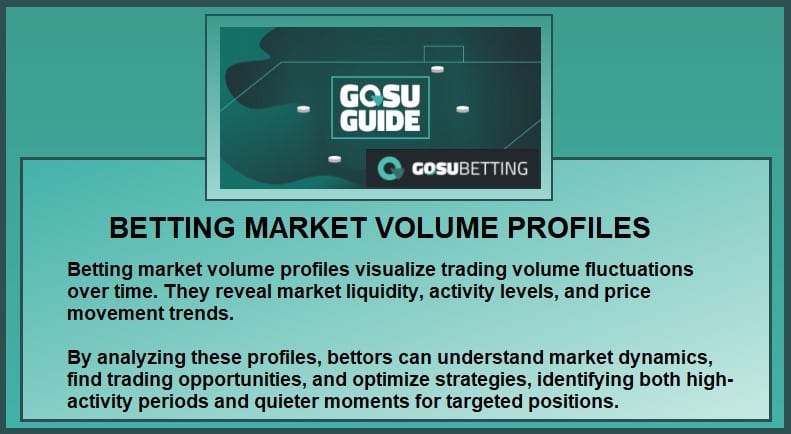For all of us who bet on sports regularly, understanding the dynamics of betting markets will become a core skill.
Welcome to an insightful guide on betting market volume profiles, a powerful analytical tool that can be used to understand the intricacies of betting market activity.
By visualising how trading volume fluctuates over time, we can glean valuable information about market liquidity, price discovery, and potential opportunities.
This article will explore the components of market volume profiles, how to interpret them, and how they can be used to improve your betting strategies.
What is a Volume Profile?

A Volume Profile is essentially a price volume chart that graphically represents the volume distribution of trading activity at different price levels within a betting market. It’s more often used when betting using betting exchanges. It is a way of visually analyzing market activity by revealing where most of the trading volume is concentrated.
Each bar on the profile shows how much money or betting interest has been exchanged at a specific price point.
In this data format, we obtain a clear, visual representation of where most of the betting action is happening and can help to identify key market activity areas.
Understanding Trading Volume and Market Liquidity
The trading volume is a core input to the volume profile because the profile charts aggregate volume at different price levels. This aggregation refers to the total amount of money wagered or traded on a specific market.
The total volume is also known as cumulative volume.
Understanding trading volume is essential for assessing the market liquidity – the ease with which bets can be placed and matched. The market flow will tend to follow the areas of highest volume, and an absence of volume can indicate liquidity issues.
High volume suggests a deep and liquid market, where trades are easily executed, whilst low volume may suggest the market is more difficult to trade. Activity analysis is used to help analyze this.
Order Book and Order Book Depth
The volume profile is also heavily informed by the order book, which shows order book depth by detailing the various buy and sell orders waiting to be matched. These are shown with limit order placement.
A profile also reflects the order quantity at each price and represents the level of interest of both buyers and sellers, highlighting the key buy and sell walls at different prices.
Analyzing the order book alongside the volume profile can provide additional insight into the potential of large orders to move prices, or cause specific outcomes.
Identifying Support and Resistance in a Market
The volume profile can help to identify support and resistance levels within a betting market. Support and resistance are levels where buying pressure or selling pressure tends to slow down, and form price ceilings and price floors respectively. These areas can act as market turning points and tend to accumulate volume clusters.
By using the volume profile, a bettor can recognize key areas of supply and demand levels and can use these to determine where a price may reverse, or where there may be more interest in the market.
The Point of Control (POC)
The point of control (POC) is the highest volume level on a volume profile and is often a key area where market activity is focused. This can also be called the volume-weighted price or a high-volume node. It is often a market pivot and can act as a key area where a price may bounce or reverse. Essentially, it’s the equilibrium point of the market.
How it Helps: The POC often becomes the most traded price point and gives insight into where traders are finding the most activity, and where they are finding the most agreement about the market’s equilibrium point.
Using Volume Clusters for Better Decisions
Volume clusters are areas within the profile where we see concentrated trading. They can act as price anchors. These high-volume areas can also act as key areas of significant volume.
Identifying the volume clusters helps reveal areas of strong interest and provides insights into the potential direction of prices. These volume hotspots can be crucial when making decisions about placing bets.
Market Activity Analysis
By assessing all of the elements of the volume profile, we can more deeply understand market behaviour. From that, we gain insights into overall trading activity.
Volume profiles give an insight into the market participants and help inform us about investor sentiment. Using this information improves our understanding of the overall market dynamics.
An overall market activity analysis can greatly improve a bettor’s overall understanding of market activity, and their ability to trade and bet more effectively.
Price Discovery
A key concept that can be understood with a volume profile is that of price discovery. This is the process of identifying the equilibrium price and can be used to assess the market information.
An efficient price level is one where buyers and sellers agree about price. The profile can show where these prices are.
A better understanding of price transparency and real-time pricing will greatly improve a bettor’s overall trading abilities by providing information on order flow dynamics.
Using Volume Profiles in Practice
Combining everything we’ve learned gets us some practical steps we can take for enhanced betting:
- Monitor Market Activity: Regularly observe how volume changes in the markets that you participate in.
- Identify Peak and Off-Peak Periods: Pay attention to the fluctuations in activity, with an awareness of the potential changes in price during these periods.
- Track Pre-Match and In-Play Volume: Identify any opportunities that are specific to either the pre-match or in-play period.
- Combine with Other Analysis: Use the market volume profiles with other analysis tools to further enhance your knowledge base and betting strategy.
Summary
In summary, volume profiles are a powerful tool for understanding the complexities of sports betting markets. They provide a visual record of market activity at various price levels, revealing valuable insights into market liquidity, trading volume, support and resistance, and overall market behavior.
A better understanding of these concepts will result in more informed decisions and more opportunities to identify areas of value in the sports betting market.
You’ll need to use an exchange like Betfair or Betdaq to get experience with volume profiles. Typically, there are no crypto bookmakers running an exchange-type operation. However, you can practice many of the other principles that drive interactions with betting markets at any of the GOSUBetting recommended crypto sportsbooks below:
Top Bitcoin Betting Sites
BC.Game
Welcome Bonus: Four-part deal up to $1,600
18+ – Gamble responsibly – GambleAware.org – T&C’s apply




